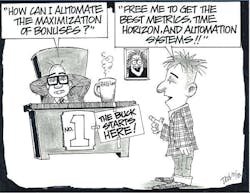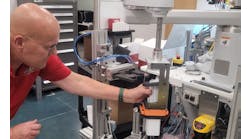This Control Talk column appeared in the November 2018 print edition of Control. To read more Control Talk columns click here or read the Control Talk blog here.
What is the Automation Federation?
Steve: AF was founded by ISA in 2006 as a separate, incorporated 501C3 with an outward focus toward the automation profession as opposed to the inward focus of organizations like ISA and others with the interest of serving and providing value to individual members. AF members, by contrast, are other organizations with some sort of vested interest in the automation profession. These areas of interest have, for the most part, been consolidated and are currently manifested in government relations activities in the U.S. and in Europe; workforce development efforts, primarily in the name of process, factory, and building automation; and advancement of IEC 62443 operational technology cybersecurity as created by ISA in ANSI/ISA 99 prior to adoption by IEC. The combined efforts of ISA and the other 19 organization AF members, plus the focused working groups, have greatly contributed to reaching people who influence our profession, with a louder voice in government, academia and industries. The work performed these past 12 years has all been toward the AF vision to be “The Voice of Automation.”
Greg: The Automation Competency Model (ACM) developed by AF, comes at a critical time in our profession. We need more than ever to see the big picture, realize the extensive automation opportunities, and seek to expand the skill set developing expertise in new technologies. We need the understanding and appreciation of the value of what we currently do and potentially can do, particularly by executives, professors and representatives. Automation professionals need to be empowered to fully take advantage of advanced functionality of instruments and controls, including the many new tools for diagnostics, modeling, performance monitoring and continuous improvement. The ACM provides the awareness and basis for moving our profession to greater heights of achievement. The opportunities for industry and academic institutions are enormous.
Steve, what is the ACM structure?
Steve: The Employment and Training Administration (ETA) within USDOL has provided the structure for all competency models and it is based on a National Institute of Standards (NIST) framework used for advanced manufacturing. It is an exploded pyramid tier diagram with function blocks in each tier related to critical work functions and the competencies required for those functions. The bottom three tiers are the foundational levels of competencies needed to be able to develop any type of career in a technology field. Tier one is related to personal effectiveness, tier two identifies academic competencies, and tier three relates these to the workplace. Once beyond the foundational tiers, by virtue of the model structure being a pyramid, the fourth tier is about competencies considered to be broad and therefore industrywide. The fifth tier becomes very specific, in our case to the automation profession as we have seen it and see it in the near future. Tier five represents the critical work functions, technical content areas, and competencies therein that define industrial automation in both the process and discrete spaces, and everything in between, with a high degree of specificity. To begin the drilldown, click on the appropriate tier block to expose the critical work functions and the competencies to follow, as well as reference publications and related standards developed according to the American National Standards Institute (ANSI) consensus process. The higher tiers were used to list job descriptions within the profession created during previous reviews of the model, which are now officially recognized positions by USDOL.
Greg: What is the AF role?
Steve: As chairman of AF in 2007 and 2008, I saw a great need for lawmakers and agencies in Washington to understand the true meaning of automation in industry, critical infrastructure and environmental areas in order to properly recognize automation as a means to be competitive in the global manufacturing marketplace; to protect our infrastructure and private-sector processing plants; and to use automation technology to more tightly control processes to increase throughput; improve quality, safety and cybersecurity; minimize waste and enable the plant to be more environmentally responsible.
A visit to the Department of Labor in 2007 gave our group the vehicle we needed when we were invited by ETA officials to develop the first of the “manufacturing” models using the NIST framework. I asked ISA Fellow and Certified Automation Professional (CAP) champion Vernon Trevathan to help develop the strawman for the automation model primarily based on his role as editor of the first edition of ISA’s A Guide to the Automation Body of Knowledge. Upon completion of the strawman, a meeting of subject matter experts from all corners of industrial automation was convened at ISA and the Automation Federation headquarters to forge the first consensus automation model. Sadly, Vernon could not attend that meeting and passed away soon thereafter. His contributions will never be forgotten.
The model was accepted and published in 2008 with reviews by AF SMEs and DOL in 2011, 2014, additions in 2017 and another full review this year, for which I thank you for your participation, Greg. We were again advised by DOL that the automation competency model is one of the most downloaded models of all, which I view as a tribute to our work in keeping it relevant and current.
Greg: I updated my chapters on “Advanced Process Control” and “Process Modeling” in the recently released third edition of ISA’s “A Guide to the Automation Body of Knowledge.” This guide, along with the sixth edition of the McGraw-Hill Handbook, “Process/Industrial Instruments and Controls” should be the core source of extensive plant-based knowledge for practitioners and students aspiring to become automation professionals. In the September 2018 ACM review, I added areas on the performance of measurements and valves including dynamics, precision, linearity and rangeability; put greater focus on proven control methods, such as basic and advanced regulatory control, procedure automation and model predictive control, and noted key functionality of the virtual plant (digital twin).
Steve, what are some of the other ACM updates?
Steve: As a group, we did not change the foundational tiers (1-3), preferring to add focus to design and development lifecycles and to rewrite operations management technical content areas with the inclusion of appropriate standards to achieve operational quality assurance (QA), and process and equipment health, safety, and environmental protection in the industrywide tier 4 area. Several tier block changes with many rewrites and even replacements of critical functions, technical content, and, of course, competencies, occurred in the automation-specific tier 5, including the changes you mention. These changes are based on changes in technology, enhanced capabilities of automation equipment, and trends in industry. The reader should really check out the whole model to get a feel for the bigger picture. For links to ACM, visit www.automationfederation.org/Focus/WorkforceDev, or the USDOL site.
Greg: How do you see ACM being used in industry, academic institutions and professional societies?
Steve: From a professional society standpoint, this model gave us definition for the industrial automation profession. The spectrum of automation in general is very broad and it was necessary to stake out the coordinates of where our member organization practitioners work and what they do. In industry and some critical infrastructure segments, employers can use this model as a tool for skills gap analysis of personnel at review time, and also to benchmark capabilities to improve job descriptions aimed at enhancing individual performance. Academic institutions can use the model as a guide for curricula development in technical colleges and enhancements to current vertical engineering disciplines by including electives for automation. In concert with intern and coop programs offered by institutions in partnership with industry, a roadmap of what automation professionals do, combined with learning the production process, can slash the time it takes new EE, ME and ChE graduates hired for automation positions to be fully productive, since there are no accredited automation engineering degree programs in the U.S. Finally, students can review this model and have a fundamental understanding of what it takes to successfully compete in the global manufacturing arena through automation. It will take this next generation of automation professionals to continue moving the needle.
Greg: Automation proficiency is critical for manufacturing safety, security, efficiency and capacity. Automation elevates the role of design, operations, and maintenance. Automation is a job creator, as we will see in the next “Control talk” column with Steve.
10. Sustainable and improvable plant profitability by best automation system is more important than project schedules or costs
9. Seek online plant performance metrics with smart time horizons and future values
8. Take the time to learn new technologies and exploit "Virtual plant virtuosity"
7. Read and understand the Sixth Edition of the McGraw-Hill Handbook, "Process/Industrial Instruments and Controls," and apply the knowledge gained, especially the best practices
6. I have read and understood the Automation Competency Model
5. No on-off valves posing as throttling valves I want "Valves that don't compromise control"
4. I want "What is truly important for measurements and valves" (5Rs)
3. No low-bid packaged equipment
2. Make innovative process control improvements
1. You decide what is best
Latest from Asset Management

Leaders relevant to this article:





